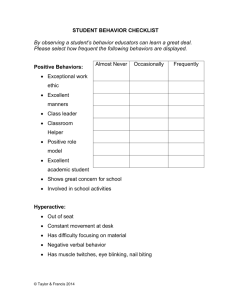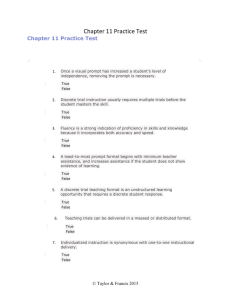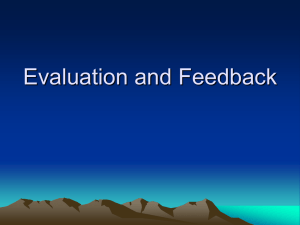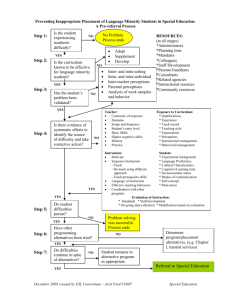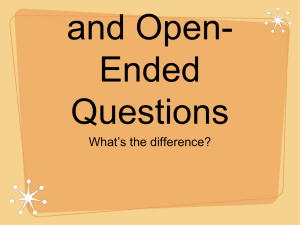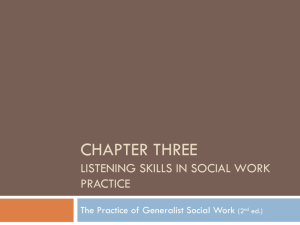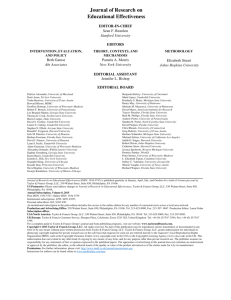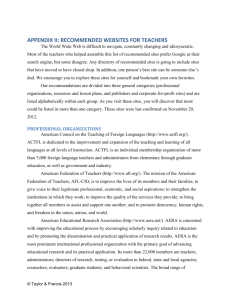Questions about Needs, Constraints & Resources
advertisement
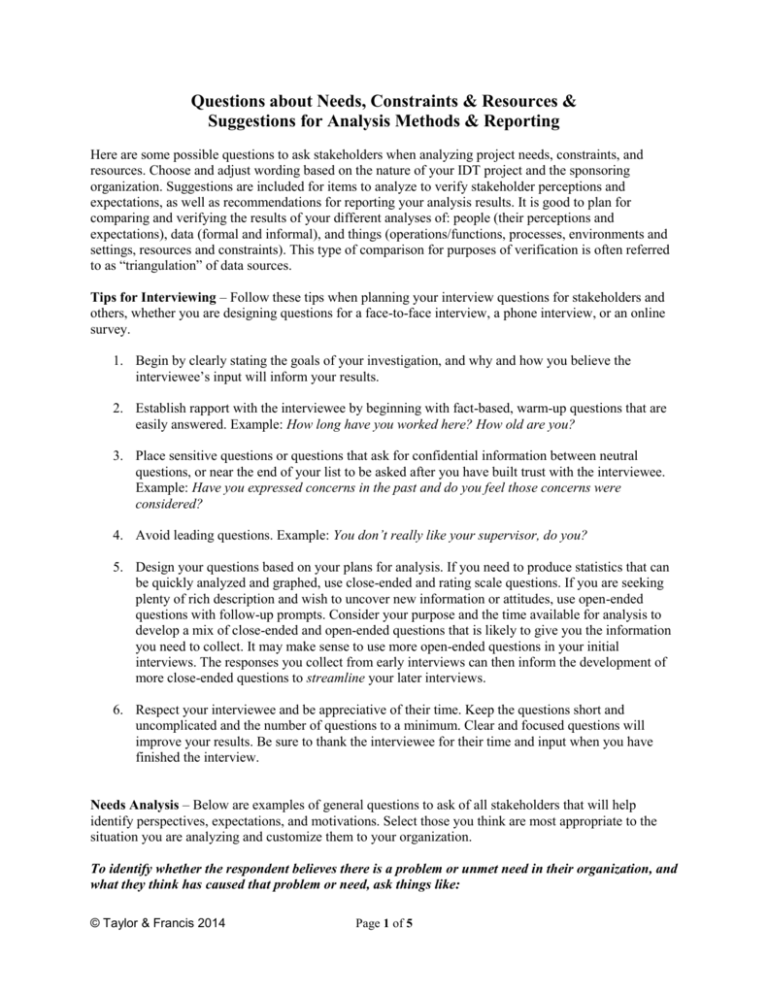
Questions about Needs, Constraints & Resources & Suggestions for Analysis Methods & Reporting Here are some possible questions to ask stakeholders when analyzing project needs, constraints, and resources. Choose and adjust wording based on the nature of your IDT project and the sponsoring organization. Suggestions are included for items to analyze to verify stakeholder perceptions and expectations, as well as recommendations for reporting your analysis results. It is good to plan for comparing and verifying the results of your different analyses of: people (their perceptions and expectations), data (formal and informal), and things (operations/functions, processes, environments and settings, resources and constraints). This type of comparison for purposes of verification is often referred to as “triangulation” of data sources. Tips for Interviewing – Follow these tips when planning your interview questions for stakeholders and others, whether you are designing questions for a face-to-face interview, a phone interview, or an online survey. 1. Begin by clearly stating the goals of your investigation, and why and how you believe the interviewee’s input will inform your results. 2. Establish rapport with the interviewee by beginning with fact-based, warm-up questions that are easily answered. Example: How long have you worked here? How old are you? 3. Place sensitive questions or questions that ask for confidential information between neutral questions, or near the end of your list to be asked after you have built trust with the interviewee. Example: Have you expressed concerns in the past and do you feel those concerns were considered? 4. Avoid leading questions. Example: You don’t really like your supervisor, do you? 5. Design your questions based on your plans for analysis. If you need to produce statistics that can be quickly analyzed and graphed, use close-ended and rating scale questions. If you are seeking plenty of rich description and wish to uncover new information or attitudes, use open-ended questions with follow-up prompts. Consider your purpose and the time available for analysis to develop a mix of close-ended and open-ended questions that is likely to give you the information you need to collect. It may make sense to use more open-ended questions in your initial interviews. The responses you collect from early interviews can then inform the development of more close-ended questions to streamline your later interviews. 6. Respect your interviewee and be appreciative of their time. Keep the questions short and uncomplicated and the number of questions to a minimum. Clear and focused questions will improve your results. Be sure to thank the interviewee for their time and input when you have finished the interview. Needs Analysis – Below are examples of general questions to ask of all stakeholders that will help identify perspectives, expectations, and motivations. Select those you think are most appropriate to the situation you are analyzing and customize them to your organization. To identify whether the respondent believes there is a problem or unmet need in their organization, and what they think has caused that problem or need, ask things like: © Taylor & Francis 2014 Page 1 of 5 Are you dissatisfied with the current situation in your organization and if so, why? What events or facts lead you to believe that something needs to change? Is there a difference between what is currently happening and what should be happening? Are current organizational needs being addressed to enable the organization to fulfill its responsibilities, obligations, and commitments? (Some of these needs can likely be addressed through instructional solutions and some must be addressed through non-instructional solutions. To verify the perceptions of individuals, examine yearly organizational goals and commitments, and current productivity and output measurements.) Are individual needs being addressed so that individuals have the knowledge, skills, and attitudes they require to be successful in fulfilling their own goals and the goals of the organization they serve or the society in which they live? (This category includes not only the need for instruction, but also the need to see the relevance of the instruction to personal goals and to the goals of the organization, and for resource and logistical support to use the new knowledge and skills in the future. Listen carefully to identify any non-instructional needs that are being neglected.) Are future organizational needs being addressed so that the organization can fulfill its stated mission and goals? If not, what future need is not being addressed? (This category also includes consideration of the present and future needs of the populations that the organization serves. To verify the perceptions of individuals, examine organizational mission statements and goals and compare to any established progress indicators or reports, and consider whether the mission and goals address the needs of the larger population or society in which the organization operates.) In your opinion, is there a problem that needs to be solved, or a challenge that needs to be addressed in your organization? How would you characterize that problem? What do you think has caused it or contributed to it? Once you have determined that the individual believes there is a problem or unmet need, ask: What measures do you think should be taken to solve the problem? How do you think the need should be met? Have there been previous attempts to meet this need and if so, what has been done and did the effort meet with any particular success or level of failure? Are there discrepancies between what the target audience should know, believe, and be able to do, and what they currently know, believe, and do? What will it look like when this need is met successfully? What results are you expecting? Do you think the current situation could be improved through instruction or a planned learning experience, and if so, why? Once you have determined that the individual believes the problem has an instructional solution, ask: What do you expect/want this instruction to accomplish? © Taylor & Francis 2014 Page 2 of 5 Has someone (you or someone else) identified the primary audience/learner for the instruction/training/learning experience? How was the learner identified? What is the anticipated size of the audience for this instruction? Do you expect the audience to grow, shrink, or remain constant over time? What prerequisite knowledge or skills are required as a basis for someone taking the proposed instruction? Are there existing materials that would be appropriate to use or to modify for the proposed instruction? What should the learner know, be able to do, and what attitudes should he/she exhibit after the instruction or learning experience? Can you describe the type of training or instruction that is usually implemented in the organization? What types of assessments are typically used? What needs other than instructional needs will impact the results? (Constraints, resources, on-the-job support, incentives, learner motivation, etc.) Constraint Analysis – For this project, how would you prioritize these three characteristics for the final instructional product: high quality, low cost, and quick completion? What schedule or deadlines have been established for this project, or what do you consider a reasonable timeframe for completion of the project? Are there established communication or delivery platforms or currently available technology that should be used? Are there differences across the organization in equipment, platform, bandwidth, connectivity, or other technical factors that must be addressed or that will complicate the deployment of this instruction? Have you already made decisions for the instruction, such as whether it will be offered face-to-face, online or in a blended format; synchronous or asynchronous; self-paced delivery or designed for small or large groups of learners; and the type of instructional, social or delivery technologies to be used? If not, do any of the key stakeholders have preferences regarding any of these items or other design decisions? What is the expected life of the instruction (in years, months, etc.)? Who will be responsible for implementation and what resources have been identified for implementation? Who will be responsible for maintaining and updating the instruction after it is implemented? Is the audience for the instruction fairly homogeneous or is there a need for language translations or customization for specific localities? If such changes are needed, have you identified a plan or resources for accomplishing them? © Taylor & Francis 2014 Page 3 of 5 Is the audience for the instruction geographically dispersed? If so, to what extent? And is there reliable technical and logistical support for the instruction in all locations? Are there likely to be bandwidth and connectivity differences between the locations where learners will access the instruction? Are there organizational policies, procedures, or guidelines that must be followed or may impact the design, development, or implementation of the instruction? Are there standards, certification, or regulatory requirements, or organizational guidelines that must be addressed in the instruction and/or met by those who complete this instruction? Are there any elements of the organizational culture that will impact the design? Do you know of any copyright restrictions that must be considered if existing organizational materials are used or modified for this project? Are there any availability issues regarding manpower, tools, or resources for the project? What type of teaching/learning strategies, activities, and learning environments do you think are most successful in helping people to learn? (This question attempts to determine whether the stakeholder has specific pedagogical experience or beliefs that you may have to consider in your design.) Do you have an opinion on the aesthetic or symbolic design of the instruction developed? Are there any logos, symbols, or branding elements you wish to see used? Is there a particular look or feel to the instruction that you would like to see implemented? What are the internal strengths and weaknesses in the organization that may enhance or inhibit the project, and what are the external opportunities and threats facing the organization and its key services/products/markets? (This is referred to as a SWOT analysis, and includes things like accreditation; technology infrastructure; reputation; support from internal and external entities such as management/faculty/students/administration; demand; expansion and quality control; globalization; diversity; competition; communications systems; long-range plans; etc.) Resource Analysis – As you analyze resources, be sure to draw a distinction between funding and resources for design/development and for implementation, and to clarify your role in determining, procuring, spending, and accounting for/reporting the use of those resources. What human and non-human resources are needed for the development and delivery of the instruction? Which of the needed resources are currently available for development and delivery, and which must still be procured? What is the budget established/available for the required human and non-human resources? What existing facilities, equipment, software, supplies, and services are available for use in designing and developing the instruction? For implementing the instruction? (If technical support is deemed necessary ...) Will there be a technical support individual or team available during development or during implementation? © Taylor & Francis 2014 Page 4 of 5 (If the designer is expected to identify the resources required ...) Do you have any guidelines for how the required resources should be formatted or reported? Have funds been appropriated for the design/development effort yet and if so, how much has been designated? If the resource requirements exceed that amount, what measures do you suggest for meeting or addressing the shortfall? Who will review the instruction for accuracy, completeness, and appropriateness? Who is ultimately responsible for approving the instruction? © Taylor & Francis 2014 Page 5 of 5
